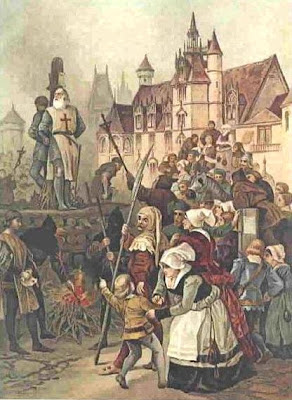
The Execution of Jacques de Molay
On Friday, October 13, 1307, King Philip IV of France ordered the Knights Templar grandmaster Jacques de Molay and scores of other French Templars to be simultaneously arrested under the accusation of various heredities. It is said that this very date sometimes spuriously is linked with the origin of the Friday the 13th superstition, because it was the beginning of the end of the powerful Knights Templar.
The Poor Fellow-Soldiers of Christ and of the Temple of Solomon (in Latin: Pauperes commilitones Christi Templique Solomonici) as the Knights Templar are called by full name, were among the most famous of the Western Christian military orders during the Middle Ages. Their organisation existed for nearly two centuries while they were able to establish fortifications throughout Europe and the Holy Land as well as a large economic infrastructure.
After the First Crusade recaptured Jerusalem in 1099, many Christian pilgrims travelled to visit their Holy Places. Though the city of Jerusalem now was under relatively secure control, the rest of the country was ruled by bandits, where pilgrims were routinely robbed or even slaughtered. At about 1119, the French knight Hugues de Payens proposed King Baldwin II of Jerusalem the instalation of a new monastic order responsible for the protection of the pilgrims. The headquarters of the newly founded order was the wing of the royal palace on the Temple Mount in the captured Al-Aqsa Mosque, which was believed to be on the ruins of the ancient Temple of Solomon. This was, how the 'Templars' received their name. First, the Order had few financial resources and relied on donations to survive, which was resembled in their emblem of two knights riding on a single horse, emphasising the Order's poverty.
But over the years, based on a mix of donations and business dealing, the Templars were able to establish financial networks across the whole of Christendom. They acquired large tracts of land, both in Europe as well as the Middle East. They bought and managed farms and vineyards, they built churches and castles, they were involved in manufacturing, import and export, they had their own fleet of ships and at one point they even owned the entire island of Cyprus. The Order of the Knights Templar arguably qualifies as the world's first multinational corporation.
 |
| The emblem of the Templars shows two knights riding on a single horse. |
Thus, on Friday, October 13, 1307 King Philip ordered de Molay and scores of other French Templars to be simultaneously arrested. The arrest warrant started with the phrase: "God is not pleased. We have enemies of the faith in the kingdom"[1]. The Templars were charged with numerous offences, including apostasy, idolatry, heresy, obscene rituals and homosexuality, financial corruption and fraud, and secrecy). Many of the accused confessed to these charges under torture, and these confessions, even though obtained under duress, caused a scandal in Paris. After further bullying from Philip, Pope Clement then issued the papal bull Pastoralis Praeeminentiae on November 22, 1307, which instructed all Christian monarchs in Europe to arrest all Templars and seize their assets [2].
As for the leaders of the Order, the Grand Master Jacques de Molay, who had confessed under torture, retracted his confession. Geoffroi de Charney, Preceptor of Normandy, also retracted his confession and insisted on his innocence. Both men were declared guilty of being relapsed heretics, and they were sentenced to burn alive at the stake in Paris on March 18, 1314. De Molay reportedly remained defiant to the end. According to legend, he called out from the flames that both Pope Clement and King Philip would soon meet him before God. Pope Clement died only a month later, and King Philip died in a hunting accident before the end of the year [2].
Learn more about the Age of the crusades and the Knights Templar in World History Crash Course by John Green about 'The Crusades'.
References and Further Reading:
- [1] "Les derniers jours des Templiers". Science et Avenir: 52–61. July 2010.
- [2] Malcolm Barber, The Trial of the Templars. Cambridge University Press, 1978.
Δεν υπάρχουν σχόλια:
Δημοσίευση σχολίου